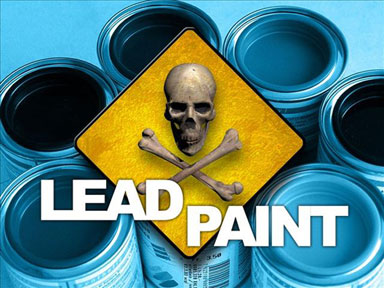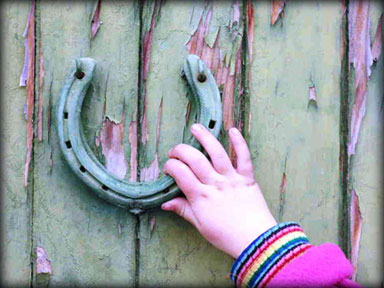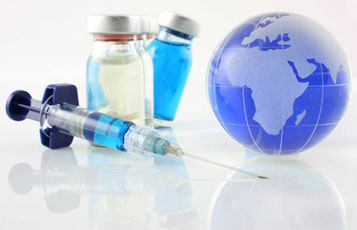|

Leaded household paints: Children most at risk
By Carol Aloysius
With the reopening of schools last month, teachers, parents, well
wishers and even senior students are currently engaged in the task of
colour-washing walls, ceilings, desks, tables and doors to create a
pleasing classroom environment for their students.
 What many of them don't know is that more than fifty percent of the
paints they use have a much higher level of lead content that what is
actually permitted by the World Health Organisation and the Consumer
Affairs Authority in Sri Lanka. What many of them don't know is that more than fifty percent of the
paints they use have a much higher level of lead content that what is
actually permitted by the World Health Organisation and the Consumer
Affairs Authority in Sri Lanka.
“Such paints can be especially injurious to children”, warns the Head
of the Toxicology Unit at the National Hospital Dr Waruna Gunathilake
who told the Sunday Observer that just inhaling the paints while inside
their classrooms for the better part of the day, children, especially
very young children in pre-schools and primary schools (i.e. from Grades
1-5) can develop serious health problems due to exposure to their toxic
fumes.
Excerpts...
Q. According to you, most indoor paints in the local market
have excessive lead content. How do you know this? Has there been a
study on the subject?
A. A study was initiated on this subject by the Centre for
Environmental Justice (CEJ) on ‘Lead content in Asian paints'. It
revealed that over 50 percent of samples tested exceeded the permitted
levels.
Q. What is the present minimum level given by the CAA?
A. The minimum level by the CAA is even less than the
international level. It is 600 parts per million (ppm). However, most of
the samples tested showed a shocking high level of lead content varying
from 1,000 ppm to as much as 100,000 ppm.
Q. Was this lead content introduced intentionally? If so why?
What are the compounds used?
A. Paint manufacturers add lead content to paints for various
reasons eg. as drying agents and catacypigments or to give a more even
finish and the pigments produces bright colours. Lead compounds commonly
used as paint pigments include lead chromates, lead oxides, lead
molybates and lead sulfates.
They are added to produce bright colours like yellow, red and green.
Lead in enamel paints are used on metal surfaces because they inhibit
rust and corrosion. The most common of them is lead tetroxide, sometimes
called red lead.
Q. So are there other paints that have less lead content in
the local market?
A. Yes. The same study by the CEJ showed that 37 percent of
the samples tested contained very low levels of below 90ppm. That proves
that technology to produce unleaded paint is widely available in this
country. You just have to look out for them.
Q. What are the health implications in general?
A. Excessive lead exposure can aggravate respiratory
conditions in people with asthma and bronchitis. Long exposure can lead
to other serious illnesses. But children are the most vulnerable victims
of such exposure.
 Q. Why? Q. Why?
A. Children are not generally exposed to lead from paint while
the paint is still in the can or even when the paint is being newly
applied to a previously unpainted or uncoated surface. Rather, the lead
exposure generally occurs after the lead paint has already dried on the
wall or on the painted surfaces that age, weather, and chip with time.
Any lead that is in the paint then enters indoor and outdoor dusts
and soil in and around the painted home or building.
Children have an innate curiosity to explore their world and engage
in developmentally appropriate hand- to mouth behaviour.
When playing in lead contaminated environments, the dust and soil
that they ingest will carry lead. This is especially true for children
in the six years and under age group, the group most easily harmed by
exposure to lead. For example, a typical one to six year old child
ingests approximately 100 milligrams of house dust and soil each day.
Q. How does that happen?
A. Paint chips can be especially harmful since their lead content can
be much higher than what is typically found in dust and soils. In some
cases, children may pick up paint chips and put them into their mouth.
In addition, when toys or other articles are painted with lead paint,
children may chew on them and directly ingest the lead - contaminated
dried paint.
Harmful
Exposure to lead is much more harmful to children than adults, and
the health effects are generally irreversible and can have a lifelong
impact.
The younger the child, the more harmful lead can be. The human foetus
is the most vulnerable, and a pregnant woman can transfer lead that has
accumulated in her body to that of her developing child.
That means that lead can poison several generations, and not only one
person during active exposure.
Q. Why are children more susceptible to lead than adults? How
does early exposure harm them?
A. Children are biologically susceptible to lead than adults
for several reasons: A child's brain undergoes very rapid growth
development and differentiation and lead interferes with this process.
Brain damage caused by chronic, low-level exposure to lead during early
years is irreversible and untreatable.
Exposure to lead early in life can re-program genes, which can lead
to altered gene expression and an associated increased risk of disease
later in life. Gastrointestinal absorption of lead is enhanced in
childhood. Up to 50 percent of ingested lead is absorbed by children, as
compared with 10 percent in adults.
In the case of children who suffer from nutritional deficiencies,
ingested lead is absorbed even more rapidly. Children with excessive
lead can also become hyperactive and unable to concentrate for long.
Evidence of reduced intelligence caused by childhood exposure to lead
has led the WHO to list lead caused mental retardation as a recognised
disease.
WHO also lists it as one of the top ten diseases whose health burden
among children can be easily prevented.
Q. Are there other vulnerable victims aprt from children?
A. Pregnant women may also absorb more ingested lead than
other adults.
Q. Your comments on leaded paints in general?
A. Good, cost-effective substitutes for all the lead compounds
that are used in making household paints have been widely available and
in use in the industrialised countries since the 1980's and before.
Any paint manufacturer that currently produces household paints with
added lead compounds could easily reformulate its paints using these
substitutes with very little (if any) impact on the characteristics of
the paints they produce or on the price.
Thus there is no good reason for a paint manufacturer to continue
producing paints with added lead compounds, especially since the
childhood health hazards associated with lead paint are very serious.
Q. Advice to parents?
A. All parents must make sure that whatever paints they use
inside their homes have either no lead or the minimum of lead. As I said
there are plenty of paints without lead. You have only to look out for
them. When you buy a toy for your child, make sure it is not one that
has been painted. A young child who puts a leaded toy to his mouth is at
risk of lead poisoning. Mothers who re-paint an old cradle or cot must
cover the entire chipped surface with unleaded paint to prevent chip
dust.
If you must re-paint the cot, then stick to white paint and don't use
bright colours which have higher lead.
Q. Any advice for the general public?
A. When you visit a supermarket or paint store, buy only paints that
have the newest SLS label (after 2013). Check if the paints carry labels
listing the amount of lead used.
If there are paints without any lead marked ‘Unleaded’ make those
your first choice.
Buy only paints from reputed dealers and NOT from wholesale outlets
where they can be diluted with lead.
Finally, if anyone in your family develops breathing difficulties
following a recent painting of the indoors, contact us on our hotline;
2686143 or the general NHSL number 2961111.
***********
[Preventing lead poisoning in children]
Lead poisoning is entirely preventable. The key is stopping children
from coming into contact with lead and treating children who have been
poisoned by lead.
The goal is to prevent lead exposure to children before they are
harmed. There are many ways parents can reduce a child's exposure to
lead. The most important is stopping children from coming into contact
with lead. Lead hazards in a child's environment must be identified and
controlled or removed safely.
***********
British birth rate leaps by 18 pc in a decade
British women are having significantly more children than a decade
ago, with birth rates for mothers in England and Wales up by 18 percent,
official figures show. Improvements in fertility treatments allowing
people to start families later and a growing population of second
generation migrants are amongst possible explanations for the rise.
|

Women born in Britain now give birth to more children |
More than a quarter of babies born in England and Wales are also now
from mothers who arrived in Britain from other countries, according to
an analysis of the latest census.
There were 724,000 births in 2011 - of which 26 percent, 185,000,
were to mothers themselves born abroad. At the last census in 2001, just
16 percent of births were to foreign-born mothers.Women born in Britain
now give birth to more children, according to the UK's total fertility
rate (TFR), which is the average number of children a woman is expected
to give birth to in her lifetime. It has risen from an average of 1.56
children to 1.84 in a decade.
The picture is similar in Scotland, where the population has
increased by 233,000 - five percent - since the 2001 census. This
represents the fastest growth rate between two Census years in the past
century. The rising population in Scotland has also been driven by
births, with 293,000 children aged under five in 2011, an increase of
six percent from 2001.
Seven percent of people in Scotland said they were born outside the
UK, an increase of three percentage points since 2001.
Mothers from Afghanistan had the highest average birth rate of 4.25,
closely followed by those from Somalia, with 4.19 and Iraq with 3.91. A
spokesman for the Office for National Statistics said that “strong
cultural preferences” were likely to be behind the marked variation in
birth rates amongst different nationalities.
Polish women were the most likely foreign-born mothers to give birth
in England and Wales overall, producing 20,500 babies in 2011. However,
the number of babies each had, on average, was 2.13 - lower than the
average for foreign-born mothers living in England and Wales.
Women born in Romania and the Czech Republic had the highest TFRs of
any EU country of birth (2.93 and 2.77 respectively). However, in 2011
these countries of birth accounted for only a relatively small number of
births - 3,500 from Romanians and 1,600 from Czechs. Oliver Dorman,
senior research officer at the Office for National Statistics, said he
thought it was possible the rise in births amongst British born mothers
was partly due to traditions of having larger families amongst second
generation migrant families.
He said: “It's likely that second generation immigrants are a factor
in this but we don't have ethnicity on birth registrations, so we don't
have the data to show that. I suspect the larger proportion of births to
non-UK born women will be contributing to the UK-born fertility rates
too, because of second generation migrants [with cultural ties to their
families’ country of origin].”
Dorman also believes women having babies later has contributed to the
rise : “We've seen over the past 10 to 15 years gradual increases in
older mothers. More and more mothers are having children at an older
age. We're seeing the same number of births for women aged 25-35 but
we're also seeing women having an additional birth later. These top up
rather than replace younger births.”
Figures released last August show this rise in births continued after
the 2011 census. Soaring numbers of babies born in the year to mid-2012
meant Britain's population rose by more than 400,000 in a single year -
the largest increase of any European Union member state - putting the
total at 63.7 million.
The Independent
‘Tidal wave of cancer’ will sweep the globe in next 20 years, warn
WHO scientists
Immediate action is required to combat a ‘tidal wave of cancer’ that
will sweep the globe in the next 20 years, scientists at the World
Health Organisation have warned.
The number of new cancer cases worldwide in a single year will rise
by 70 percent from 14.1 million in 2012 to 24 million in 2035, the WHO's
International Agency for Research on Cancer (IARC) said in their latest
World Cancer Report.
|

Cancer is becoming more preventable but less developed
countries could see a rise in cases |
The future global burden of cancer will increasingly shift to poorer
countries, WHO said, but it added that half of all world cancers are now
preventable with existing medical knowledge and expertise.
Annual deaths from cancer will almost double in the same time period
from 8.2 million to 14.6 million. One of the report's editors, Dr
Bernard Stewart from Australia, said that modifications to human
behaviour, such as reducing alcohol consumption, would play a “crucial
role in combating the tidal wave of cancer which we see coming across
the world”.
“In relation to alcohol, for example, we're all aware of the acute
effects, whether it's car accidents or assaults,” he said.
“But there's a burden of disease that's not talked about because it's
simply not recognised, specifically involving cancer.
“The extent to which we modify the availability of alcohol, the
labelling of alcohol, the promotion of alcohol and the price of alcohol
- those things should be on the agenda.”
Less developed countries will see an increase in cancer incidence -
the number of new cases per year - of 44 percent in the next decade,
whereas in richer countries, incidence rates will only increase by 20
percent.
The inequalities are largely down to varying levels of access to both
cancer treatments and preventative healthcare - such as screening
programs and vaccines for cancers caused by infections like the human
papilloma virus (HPV).
However, the gap between countries will widen as people in less
developed nations increasingly adopt “industrialised lifestyles” -
smoking and drinking more, and eating more highly processed food.
Dr Christopher Wild, said it was clear the world would never “treat
its way out of cancer” and emphasised the role that prevention should
play in years to come.
- The Independent
|

